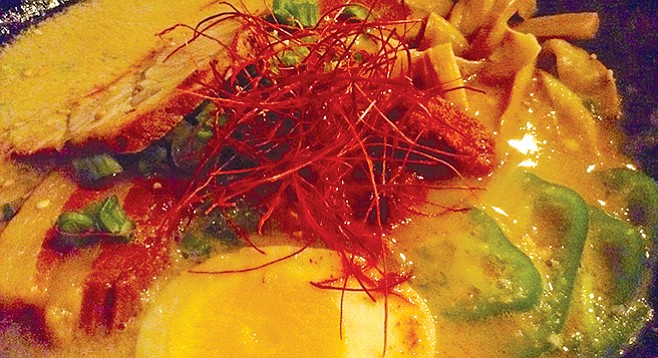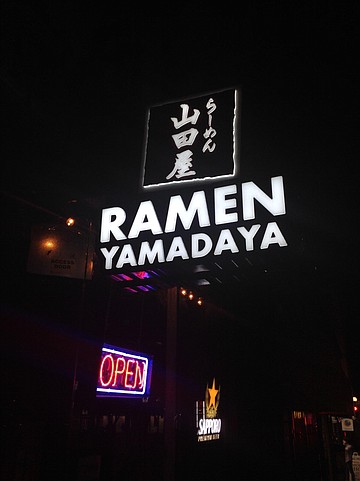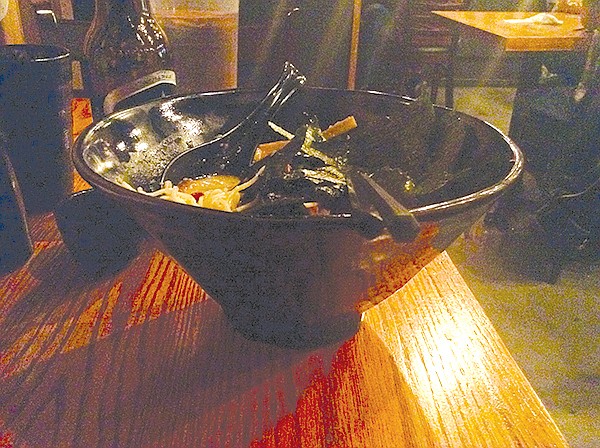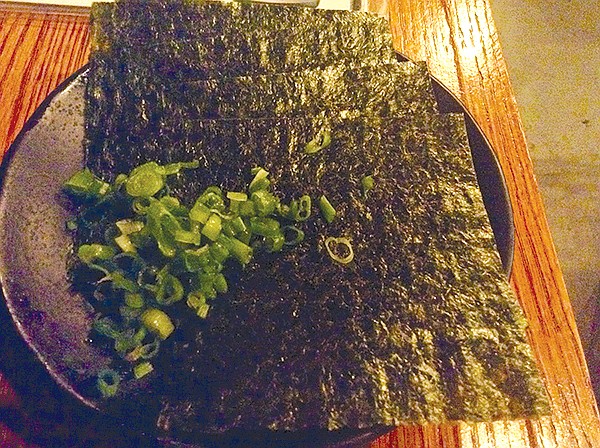 Facebook
Facebook
 X
X
 Instagram
Instagram
 TikTok
TikTok
 Youtube
Youtube

Wow. Downtown. This scuzziest part of Broadway, around Fifth, is suddenly taking off. Guess the facelift started with the opening of the park at Horton Plaza, but now eateries are opening one after the other, lickety-split. There’s Bravo Carne Asada, a new Mex joint. Next door is Biga, an Italian-style café that offers pizza.
Ah, and there’s the little place I’m looking for. Ramen Ramadaya. Yes, yet another ramen joint. But this is the one a friend of mine has been oohing and aahing over. Something about their pork loin.
“Ask for Kakuni Ramen,” he said.

So, I go inside to a kinda three-table street-level section, and then down stairs, or down a ramp, to the main room.
“Welcome!” the two servers call out. Never been to Japan, but the atmosphere here feels real. Crowded, with busy big tables, little intimate couple tables, a wall of vertical wooden slats on one side and etched stone on the other, and cooks at the back wearing black bandannas. Plus, visual bonus: when people come down the ramp behind the slats, they look like movable art.
Deborah, one of the servers, shows me to a table by the stone wall. The other girl’s bringing a big black bowl of some steaming noodle dish to the guy at the next table.

“It’s Tonkotsu Shoyu,” he says, when I ask. Name’s Austin. Has spent time in Tokyo. “This is good. It’s all in the broth.”
“The rich flavored soup is cooked with pork bones after more than 20 hours of boiling,” says the menu. “For the first ten hours, the cauldron is boiled with the strong fire to break bones into flakes. Then it is simmered for another ten hours to extract the genuine pork bone broth.”
I see they have a whole side devoted to tonkotsu. Seems tonkotsu is that pork bone used to flavor the soup. (It’s not the same as tonkatsu, which is a cutlet of pork.)
Shoyu means “soy.” Tonkotsu Shoyu is a bunch of pork on top of ramen noodles in the ramen soup, with a “Tokyo-based soy sauce,” whatever that is. Costs $9.45.
But what my buddy was talking about is Kakuni Ramen. Three bucks more.
Deborah says it has everything Austin’s bowl has plus a big slab of pork belly floating across the top.

So by now the other gal, Moon, has come to take my order. She’s from Mongolia. I order the Kakuni Ramen ($12.95). Kakuni refers to the square-cut braised pork belly. Then I spot something about dried seaweed, so I add that for another dollar. Then I see their sake page. Can’t resist the house sake ($7); plus, may as well take a beer chaser, so I get a bottle of Sapporo ($4.50). Ouch. I know I’m gonna be 30 bucks lighter before I make it out onto Broadway. Carla’s gonna kill me. But, hey, this is payday.
Also, the deal is you can take any tonkotsu dish with the kakuni ramen. And I see they have a tonkotsu spicy. “I’ll take that,” I say.
“Do you want level one, two, or three?” says Moon.
Level 3 is “very hot.”
“I’ll take level 3,” I say, because I know the Japanese are nowhere near, say, the Thais, when it comes to laying on the heat.
When my big black bowl turns up, it is worth it. We’re talking rich, pork-flavored soup with this floating island of goodies on top: the pork belly, plus chunks of barbecued pork loin, half a boiled egg, scallions, mushrooms, green peppers, and, underneath, this viper pit of ramen noodles. And on top, like a little frilly wig, a scramble of red spiky things.
“Shrimp feelers?” I ask.
“No! These are red bell pepper shavings quickly fried,” says Moon.
“And is this, like, 100-year-old egg?”
“No, no!” she says. “That’s a Chinese custom. Japanese people don’t do that.”
Oops.
Actually, it is all too delish. I was right about the spice heat level 3. Nothing extreme. Even though they’ve tossed in jalapeño slices and a big splot of chili sauce with cayenne peppers. And the big flattened square of seaweed seems a little spicy, too, when I break it up and scatter it over everything.
The most delicious thing? This half-inch-thick juicy, soy-flavored pork-belly slab. Tons of fat hanging on to it. Beautiful flavor.
Or maybe most delicious is the ramen noodles, which have their own porky flavor. Or maybe it’s the soup that conquers all, because the more you get it down, the richer it becomes.
Of course, drink and chat help. The sake (hot) is the house one but totally fine, and Austin is a gold mine on Tokyo. “Ramen’s ordinary-people’s food over there,” he says. “Sushi is more elite. Your plate would cost about 600 yen. Say, six bucks.”
Huh. One yen, one cent?
“But for those prices you have to go into the narrow passages. They’re always crowded. The ramen stalls or yakitori — fried meat on skewers — places each have little counters there with maybe two, three seats. That’s it. They’re great.”
He looks at the stubby bottle of Kagua, a beer from Japan he’s drinking. “This cost $13,” he says. “Tastes great, but not worth 13 bucks.”
Of course, it’s only after, when I check the rest of the menu, that I see they actually have lots of small, cheap dishes. Like, $3.95 for pork-belly-stuffed yamadaya buns, or $5.95 for a spicy tuna bowl. Or $7.95 for a kara-age (deep-fried) chicken, or $5.95 for a yamadaya salad.
Sigh. Guess that’s all for next time. All I gotta do now is drink my soup down. As it gets richer and richer, that’ll be no problem.
Hours: 11:30 a.m.–9:30 p.m. daily
Prices: Pork belly–stuffed yamadaya buns, $3.95; spicy tuna bowl, $5.95; kara-age (deep-fried) chicken, $6.95; yamadaya salad, $5.95; curry rice bento, $7.95; tonkatsu pork, $9.95; tonkotsu shoyu, $9.95; kakuni ramen with tonkotsu spicy ramen, $12.95; tonkotsu kotteri (with black garlic oil), $9.95; small spicy tuna bowl and small salad, $4.95; gyoza (4 pieces) and small salad, $3.95; vegan ramen, $9.45
Buses: all downtown, including 2, 3, 30, 50, 110, 120, 215, 235, 901, 923
Nearest bus stop: Broadway at Fifth
Trolley: Blue Line, Orange Line
Nearest Trolley Stop: Fifth Avenue


Wow. Downtown. This scuzziest part of Broadway, around Fifth, is suddenly taking off. Guess the facelift started with the opening of the park at Horton Plaza, but now eateries are opening one after the other, lickety-split. There’s Bravo Carne Asada, a new Mex joint. Next door is Biga, an Italian-style café that offers pizza.
Ah, and there’s the little place I’m looking for. Ramen Ramadaya. Yes, yet another ramen joint. But this is the one a friend of mine has been oohing and aahing over. Something about their pork loin.
“Ask for Kakuni Ramen,” he said.

So, I go inside to a kinda three-table street-level section, and then down stairs, or down a ramp, to the main room.
“Welcome!” the two servers call out. Never been to Japan, but the atmosphere here feels real. Crowded, with busy big tables, little intimate couple tables, a wall of vertical wooden slats on one side and etched stone on the other, and cooks at the back wearing black bandannas. Plus, visual bonus: when people come down the ramp behind the slats, they look like movable art.
Deborah, one of the servers, shows me to a table by the stone wall. The other girl’s bringing a big black bowl of some steaming noodle dish to the guy at the next table.

“It’s Tonkotsu Shoyu,” he says, when I ask. Name’s Austin. Has spent time in Tokyo. “This is good. It’s all in the broth.”
“The rich flavored soup is cooked with pork bones after more than 20 hours of boiling,” says the menu. “For the first ten hours, the cauldron is boiled with the strong fire to break bones into flakes. Then it is simmered for another ten hours to extract the genuine pork bone broth.”
I see they have a whole side devoted to tonkotsu. Seems tonkotsu is that pork bone used to flavor the soup. (It’s not the same as tonkatsu, which is a cutlet of pork.)
Shoyu means “soy.” Tonkotsu Shoyu is a bunch of pork on top of ramen noodles in the ramen soup, with a “Tokyo-based soy sauce,” whatever that is. Costs $9.45.
But what my buddy was talking about is Kakuni Ramen. Three bucks more.
Deborah says it has everything Austin’s bowl has plus a big slab of pork belly floating across the top.

So by now the other gal, Moon, has come to take my order. She’s from Mongolia. I order the Kakuni Ramen ($12.95). Kakuni refers to the square-cut braised pork belly. Then I spot something about dried seaweed, so I add that for another dollar. Then I see their sake page. Can’t resist the house sake ($7); plus, may as well take a beer chaser, so I get a bottle of Sapporo ($4.50). Ouch. I know I’m gonna be 30 bucks lighter before I make it out onto Broadway. Carla’s gonna kill me. But, hey, this is payday.
Also, the deal is you can take any tonkotsu dish with the kakuni ramen. And I see they have a tonkotsu spicy. “I’ll take that,” I say.
“Do you want level one, two, or three?” says Moon.
Level 3 is “very hot.”
“I’ll take level 3,” I say, because I know the Japanese are nowhere near, say, the Thais, when it comes to laying on the heat.
When my big black bowl turns up, it is worth it. We’re talking rich, pork-flavored soup with this floating island of goodies on top: the pork belly, plus chunks of barbecued pork loin, half a boiled egg, scallions, mushrooms, green peppers, and, underneath, this viper pit of ramen noodles. And on top, like a little frilly wig, a scramble of red spiky things.
“Shrimp feelers?” I ask.
“No! These are red bell pepper shavings quickly fried,” says Moon.
“And is this, like, 100-year-old egg?”
“No, no!” she says. “That’s a Chinese custom. Japanese people don’t do that.”
Oops.
Actually, it is all too delish. I was right about the spice heat level 3. Nothing extreme. Even though they’ve tossed in jalapeño slices and a big splot of chili sauce with cayenne peppers. And the big flattened square of seaweed seems a little spicy, too, when I break it up and scatter it over everything.
The most delicious thing? This half-inch-thick juicy, soy-flavored pork-belly slab. Tons of fat hanging on to it. Beautiful flavor.
Or maybe most delicious is the ramen noodles, which have their own porky flavor. Or maybe it’s the soup that conquers all, because the more you get it down, the richer it becomes.
Of course, drink and chat help. The sake (hot) is the house one but totally fine, and Austin is a gold mine on Tokyo. “Ramen’s ordinary-people’s food over there,” he says. “Sushi is more elite. Your plate would cost about 600 yen. Say, six bucks.”
Huh. One yen, one cent?
“But for those prices you have to go into the narrow passages. They’re always crowded. The ramen stalls or yakitori — fried meat on skewers — places each have little counters there with maybe two, three seats. That’s it. They’re great.”
He looks at the stubby bottle of Kagua, a beer from Japan he’s drinking. “This cost $13,” he says. “Tastes great, but not worth 13 bucks.”
Of course, it’s only after, when I check the rest of the menu, that I see they actually have lots of small, cheap dishes. Like, $3.95 for pork-belly-stuffed yamadaya buns, or $5.95 for a spicy tuna bowl. Or $7.95 for a kara-age (deep-fried) chicken, or $5.95 for a yamadaya salad.
Sigh. Guess that’s all for next time. All I gotta do now is drink my soup down. As it gets richer and richer, that’ll be no problem.
Hours: 11:30 a.m.–9:30 p.m. daily
Prices: Pork belly–stuffed yamadaya buns, $3.95; spicy tuna bowl, $5.95; kara-age (deep-fried) chicken, $6.95; yamadaya salad, $5.95; curry rice bento, $7.95; tonkatsu pork, $9.95; tonkotsu shoyu, $9.95; kakuni ramen with tonkotsu spicy ramen, $12.95; tonkotsu kotteri (with black garlic oil), $9.95; small spicy tuna bowl and small salad, $4.95; gyoza (4 pieces) and small salad, $3.95; vegan ramen, $9.45
Buses: all downtown, including 2, 3, 30, 50, 110, 120, 215, 235, 901, 923
Nearest bus stop: Broadway at Fifth
Trolley: Blue Line, Orange Line
Nearest Trolley Stop: Fifth Avenue
Comments